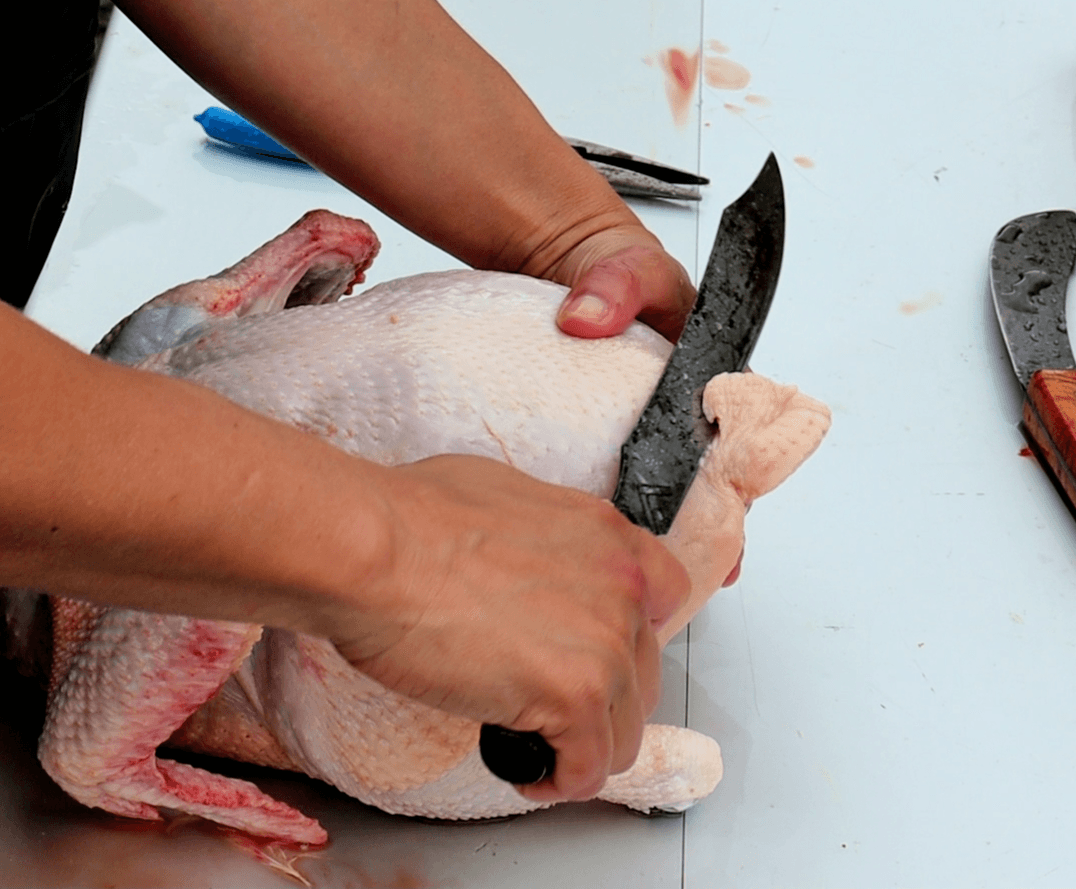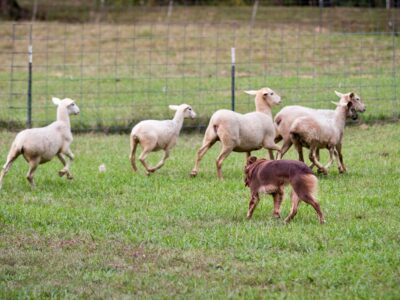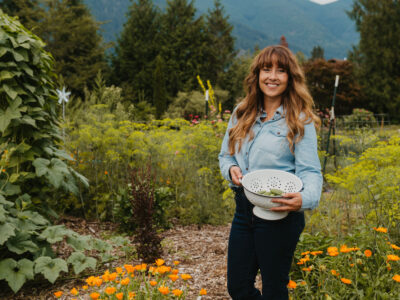Knowing how to butcher a chicken at home is a skill not for the faint of heart, but one essential if you want to be self-sustainable and raise your own livestock from start to table. We've been butchering our own chickens for 6+ years now and have learned a few things over the years to streamline the process.
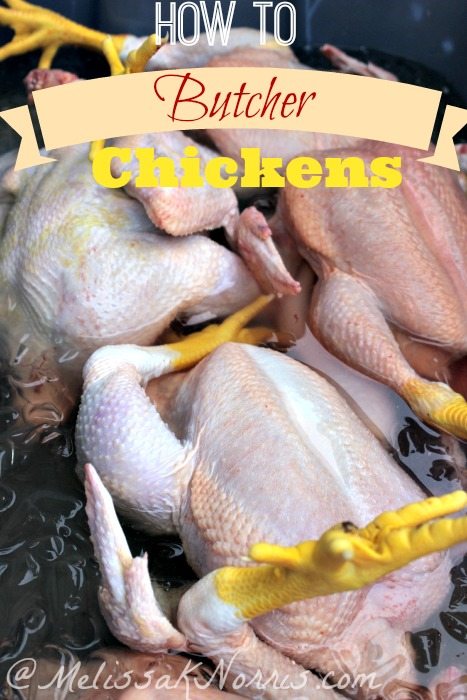
I know many people hire out the butchering of their meat animals. We do it for our cattle, one due to the size of them, but more importantly because we don't have the equipment, including a cooler for allowing the meat to age properly.
But knowing how to butcher a chicken is quite different from knowing how to butcher a full-size cow at home.
We have butchered our own pigs, but this fall, we'll be sending the pair of pigs we have now to the local butcher.
For those of you wanting to know how to butcher a live chicken, then this is the post for you. I did my best to take tasteful pictures of butchering a chicken at home, but if the sign of blood makes you faint, either grab the smelling salts and a soft pillow or have someone read you the post so you don't see the pics, okay?
Listen in below to the full podcast, Episode #263 How to Butcher a Chicken at Home, of the Pioneering Today Podcast, where we don’t just inspire you, but give you the clear steps to create the homegrown garden, pantry, kitchen, and life you want for your family and homestead.
If you missed How to Raise Meat Chickens you can catch it here.
How to Butcher a Chicken at Home
1. Rent the equipment. Having the right equipment makes all the difference. For $27 we were able to rent from our local county agriculture extension office all of the chicken butchering equipment including the cones, the scalding tank, and the big most lovely thing in the world when it comes to butchering chickens, the automatic plucker!
If you can't rent it, here is the equipment you can order online.
Equipment for Butchering Chickens
- A kill cone is essential, no missing the chicken with an ax or having it flopping all over (this seems to be the one thing people say when they watched as a kid that stayed with them in a negative way)
- a boning knife (my husband made ours but this is a similar blade)
- scalding tank – trust me, you'll never want to butcher a chicken without a scalding tank, it makes plucking so much easier
- automatic chicken plucker
- hose for rinsing
- stainless steel table for processing
- garbage can/bucket for guts
- ice chest with ice to put finished chickens in
- bags for feet/hearts
- thermometer for measuring scalding tank temperature
2. Take away the food. The night before butchering chickens remove their food. You don't want to have food in the crop of the chicken (the area they hold their food in before swallowing) when removing.
3. Set it all up before you begin to butcher the chickens. Light the scalding tank before you're ready to make sure you know how and it's working. Hook up the water hose and extension cord to the plucking machine (only requires 110 volt). Turn it on, make sure it works. Have all of your knives sharpened and laid out. You'll need to turn on the scalding tank (it's propane, so know how to light the pilot light) a few hours before butchering to heat the water. You want the water at 140 to 150 degrees Farhenheit. Too hot and you'll tear the skin when plucking.
4. Got ice? Wash out a large bin and fill it with some ice and cold water. We placed all of the chickens in here after they'd been plucked, but before gutting and removing the feet. Have an extra bag of ice handy to put the finished chickens in before you begin wrapping them for freezing
How to butcher a chicken
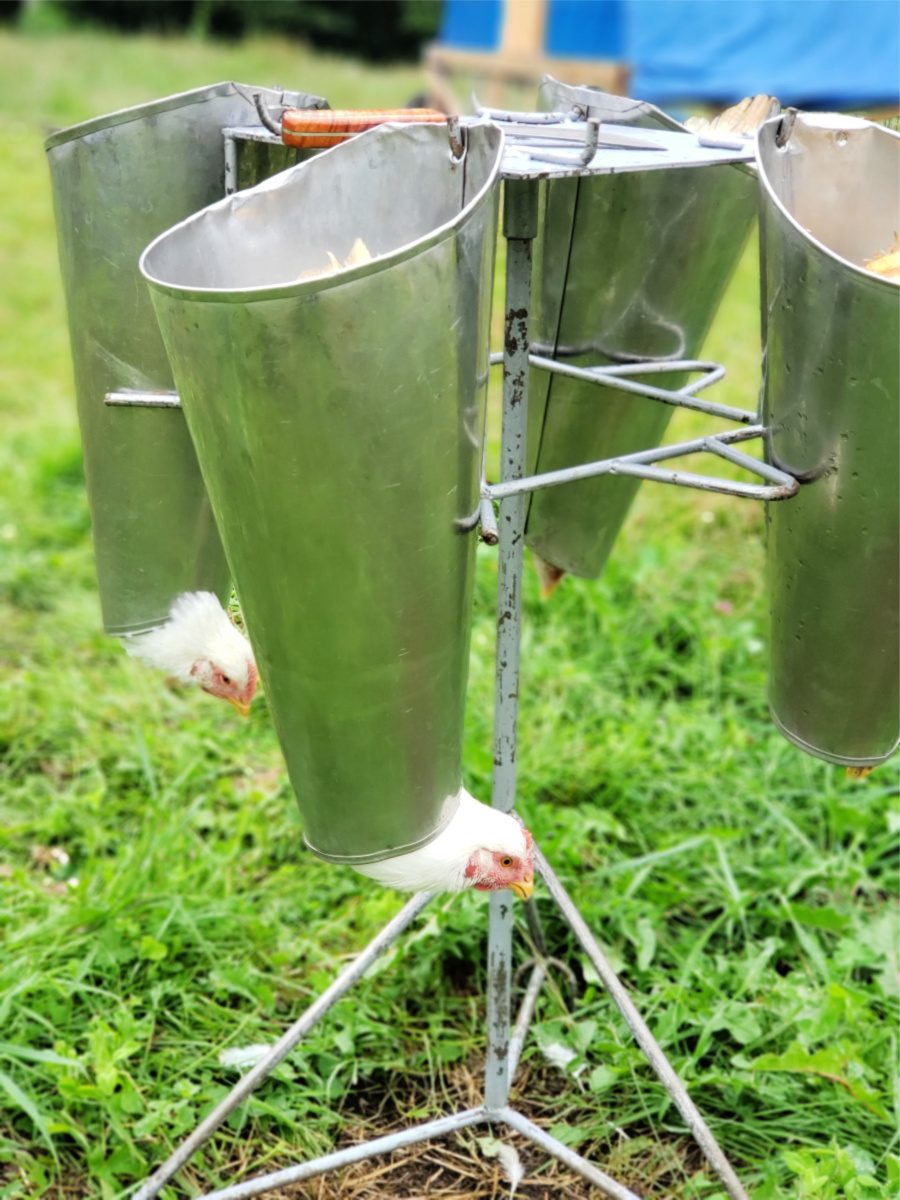
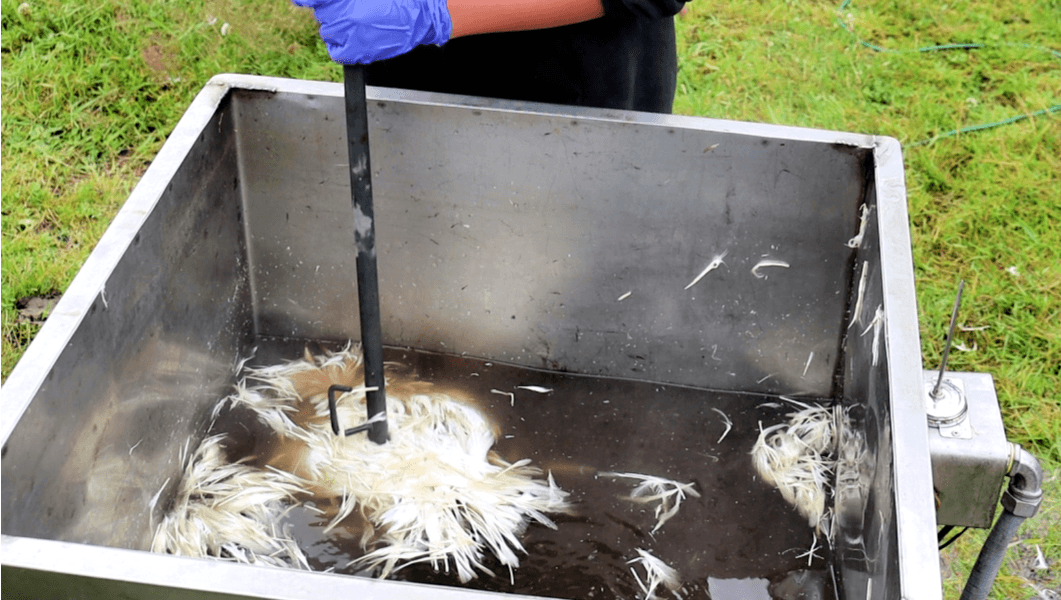
5. Place the chickens in the cone. Their head hangs down allowing you to make a clean cut. Note: We don't just slit the throat, we completely cut off the head of the chicken. Knowing how to slaughter or kill a chicken at home seems brutal to some, but we feel it's much more humane to know the whole process of butchering a chicken yourself and making sure it's done in the quickest and kindness way possible. Allow the blood to drain out, it only takes a few minutes.
6. Dunk chicken in the scalding tank. About 1 to 2 minutes of dunking the chicken in the scalding tank are just right. Too long, and you'll begin to cook the skin and it will tear upon plucking. Be warned, this is the stinky part. If you can do this on a cool day, you'll be much happier. We use a metal hook rather than holding by the feet so that the feet are submerged and skinned at the same time (so much easier when using the feet in broth if they're skinned on butcher day). Feathers should easily come out if you gently tug on them.
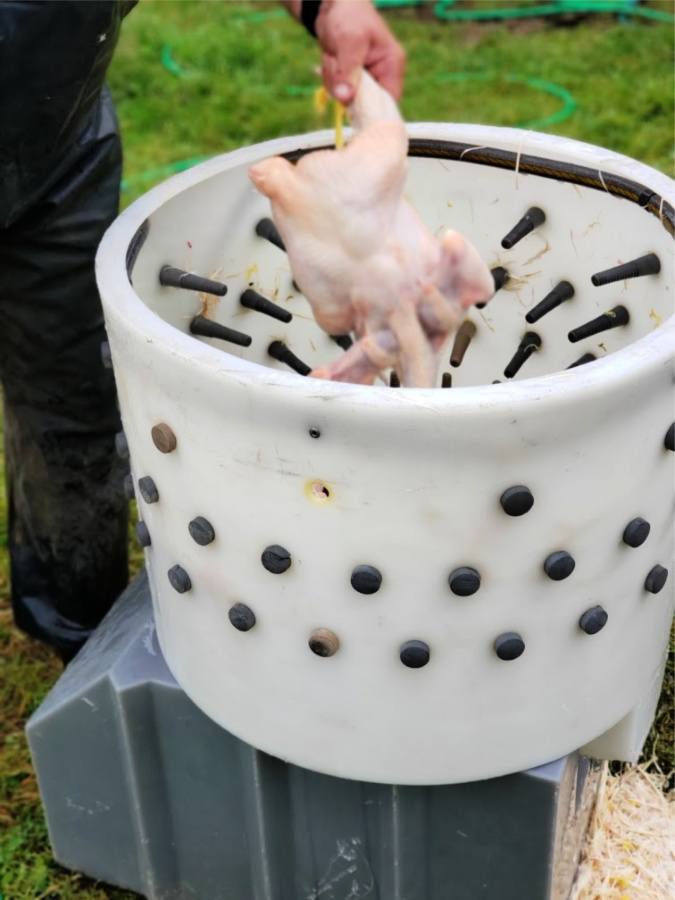
7. Place chicken in the plucking machine. It doesn't take long for this little beauty to pluck all the feathers off. It also rinses the chicken at the same time. Is there anything pretty than a bald chicken? (Okay, while butchering, I mean otherwise I just sound really weird…)
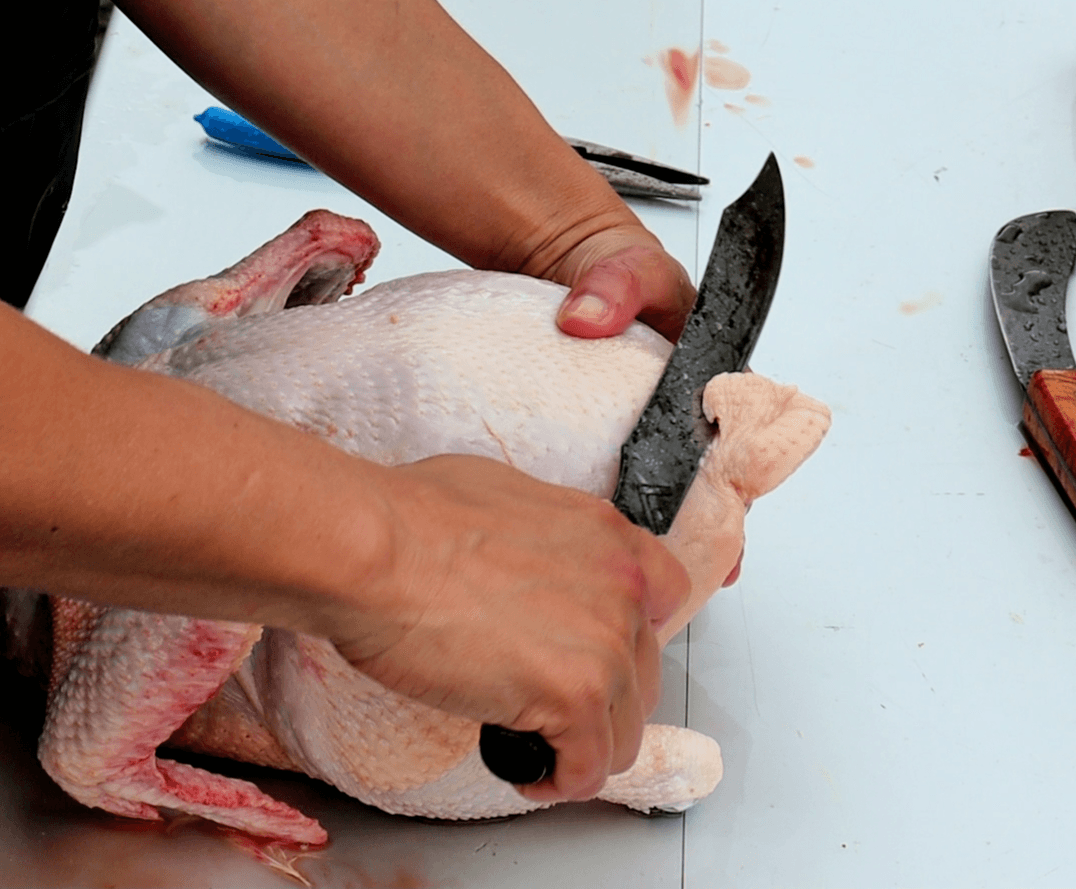
8. Create an assembly line. Don't try to cut up each chicken from start to finish before moving onto the next. We placed all the plucked chickens in the ice water bath until they were all done.
9. Remove the preening oil gland. Place your bird breast side down, and push the tail up so the oil gland is sticking up. Cut this off (it can make the meat taste funny if you leave it).
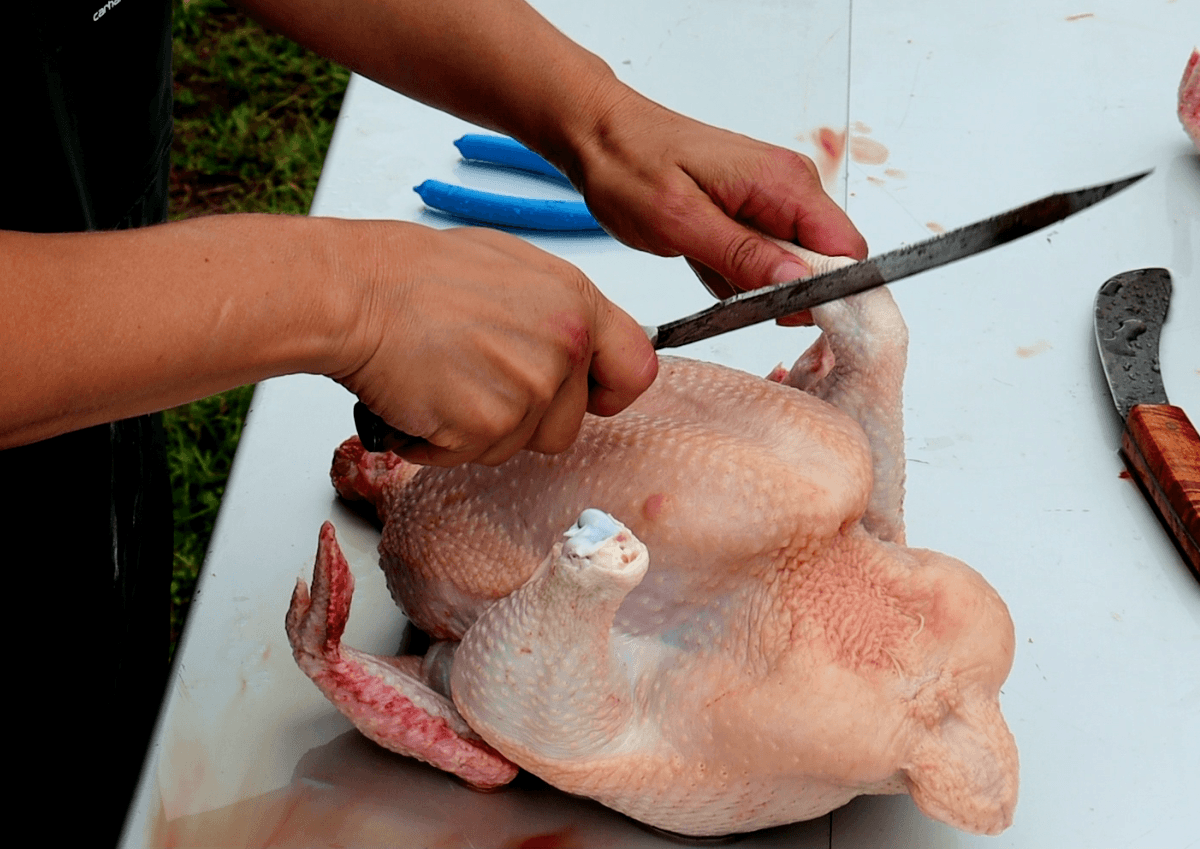
10. Cut off the feet. At the joint of the leg, cut off the chicken feet. You can save these to make a gelatinous broth or toss them. Up to you. Personally ,I keep the feet, for real, best broth evah!
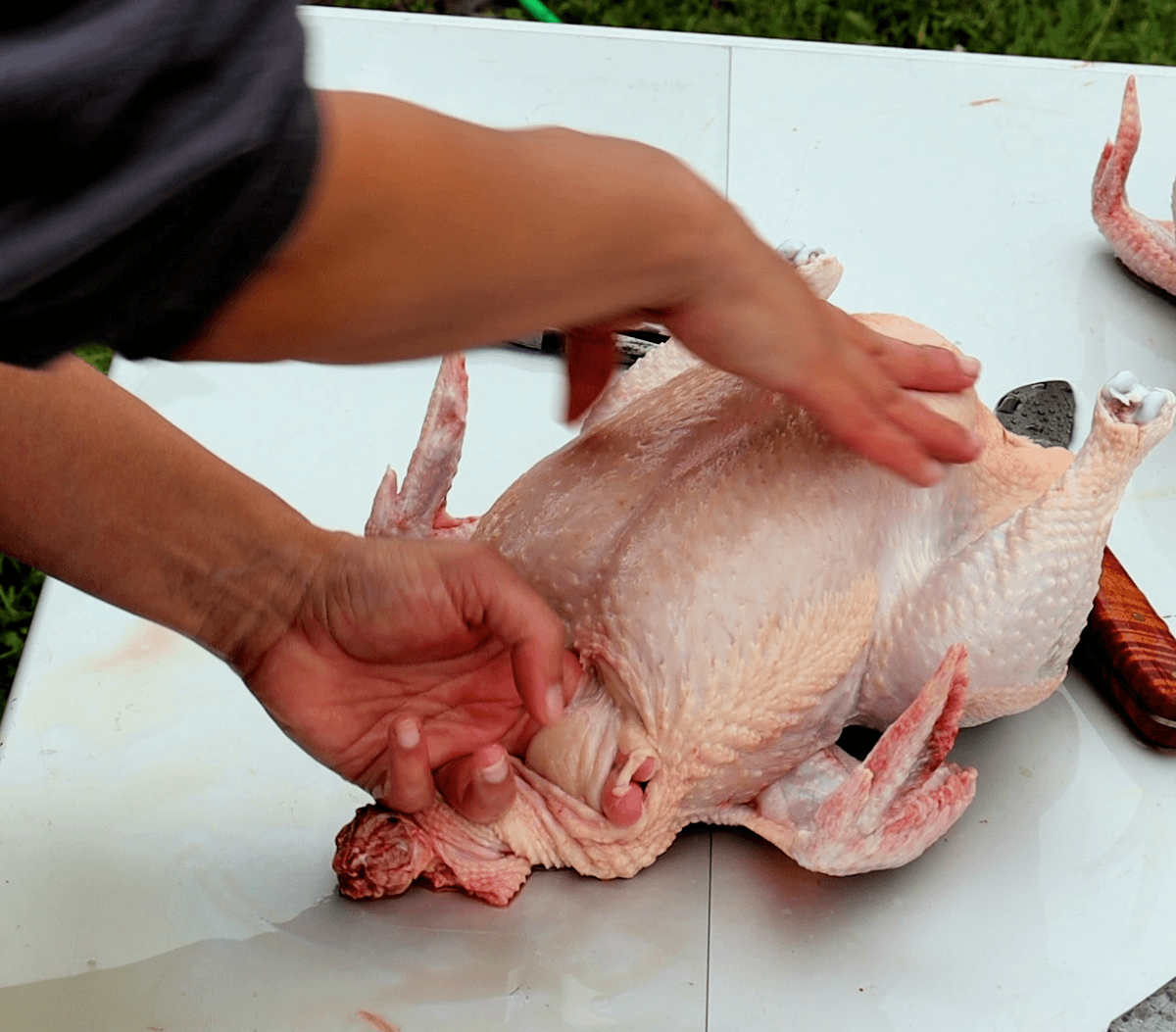
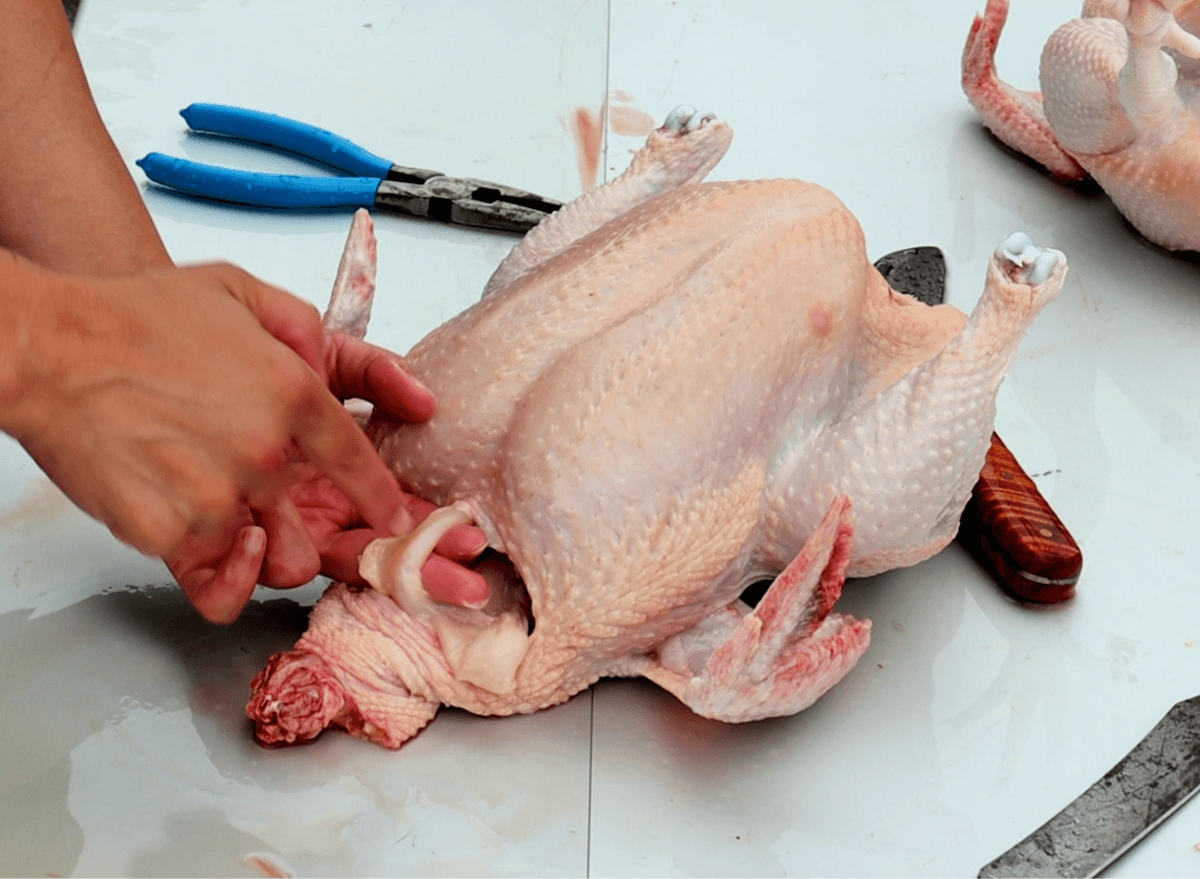
11. Cut between the dimple above the neck and below the breast. Pull the craw loose, hook your finger behind it and pull it loose from the neck, but not out of the chicken.
12. Pull the windpipe loose.
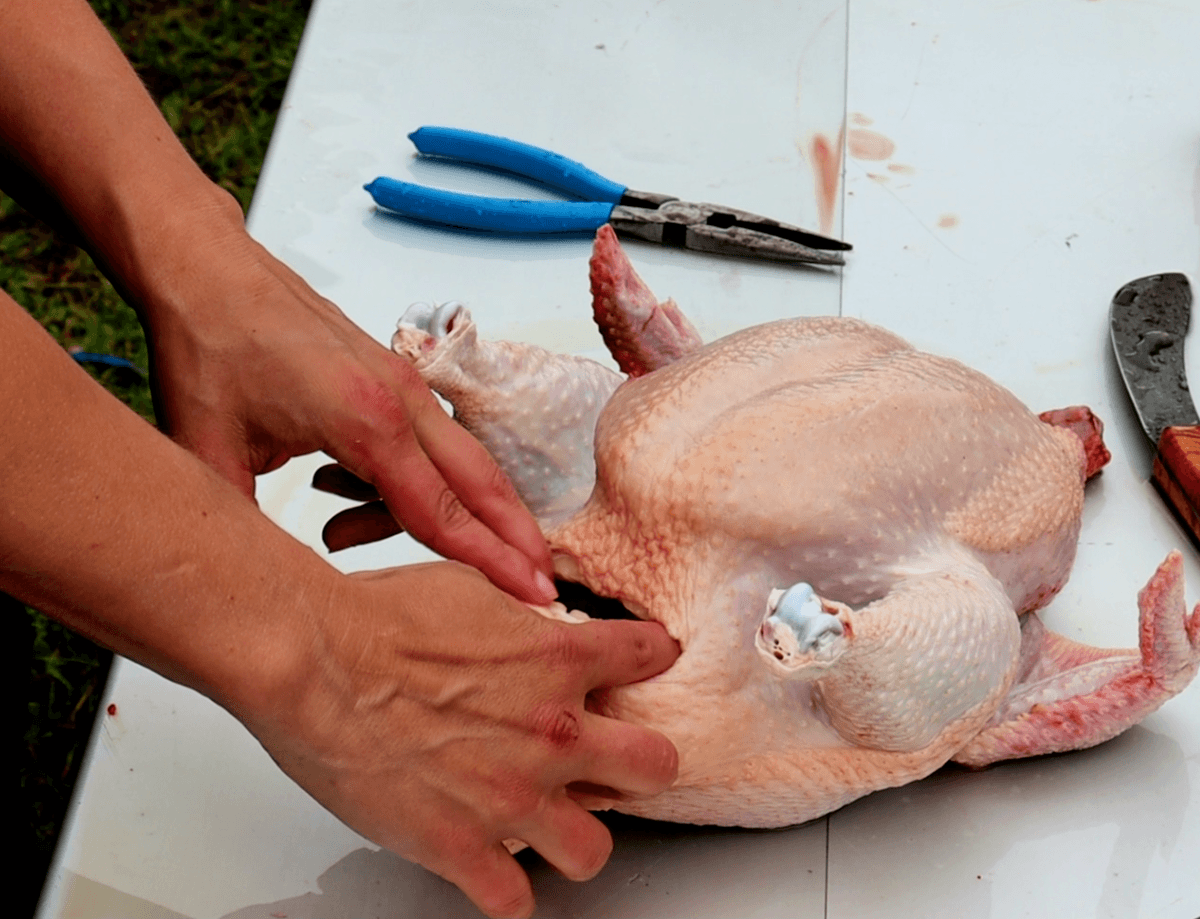
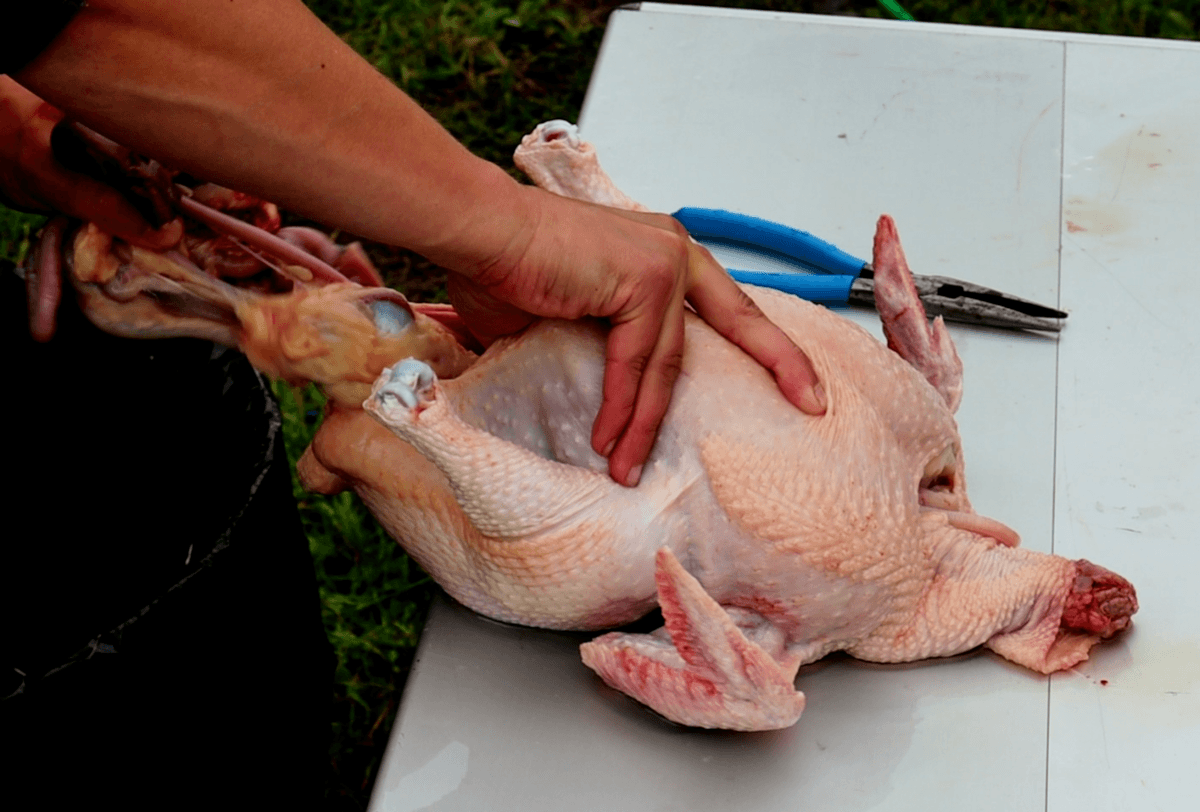
13. Gut your chicken. Take your butcher knife and cut a horizontal slit to pull the intestines and organs.
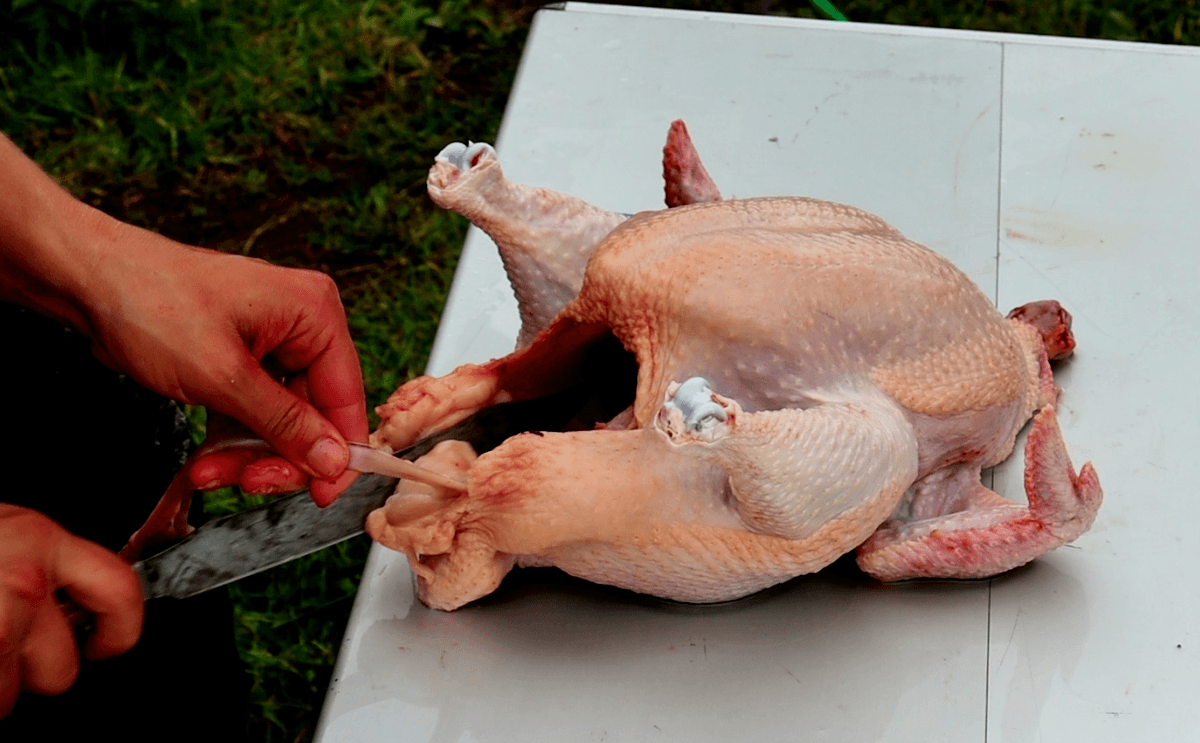
14. Have a bucket or garbage bag to discard guts and intestines. If it's hot out, you may want to fill the buck with some water to keep the flies at bay. Pull out the organs (save the heart and liver if you wish), guts, and lungs. Let the weight of the intestines pull the anus down and make a v-cut around it to remove fully.
15. Rinse chicken thoroughly. Rinse chicken off again under cold running water.
16. Allow chicken to rest. Place chicken in an ice chest with ice and allow to rest anywhere from 6 to 24 hours. We were finished butchering at 1 pm in the afternoon and I packaged ours and placed in the freezer at 8 pm that evening (we ran out of ice).
17. Package chickens. In the past, I've used produce bags from the grocery store but this year we purchased the shrink bags here (this was the best price we found) To use the shrink bags, heat a pot of water to 180 degrees F. Place chicken inside the bag and dip into heated water for 5 to 10 seconds, pull out and immediately tie with twist ties. Place in freezer.
We chose to freeze our chickens whole to roast later. Pressure canning your chicken is another storage option. You can watch my free Pressure Canning Video Series here.
We butchered 26 chickens and it took about two hours. The birds were 8-week-old Cornish cross and average 5 to 5.5 pounds (a few were under 5 pounds and some almost 7 pounds) fully dressed. (Here's more on why we raise Cornish Cross, 10 Tips on Raising Chickens for Meat )
Are home butchered chickens tough
No. I usually let my birds thaw in the fridge for 2 days (beings I only let them rest 6 hours on butcher day) and have never had a tough bird. I've baked, smoked, cooked, and oven-roasted chickens (here is how to cook a whole chicken in an hour from frozen) with never an issue, they've always been extremely flavorful, tender, and moist.
There you have it, all the steps from start to finish on how to butcher a chicken at home.
So there you have it, how to kill or butcher a chicken at home.
Have you ever butchered your own meat? Do you have any tips?
More Articles on Raising Chickens
- 5 Tips to Raising Backyard Chickens
- Breeding Chickens Naturally: Selective Breeding for Eggs & Chicks
- Raising Chicks – Beginner's Guide to the First 6 Weeks
- Using Chickens in the Garden
- Storing & Preserving Eggs Farm Fresh Eggs Primer
- 10 Tips on Raising Chickens for Meat
- Raising Chickens for Profit
- Stocking Up on Animal Feed (+ How Much to Feed Animals)
- Planning Your Livestock for a Year's Worth of Meat Per Person
